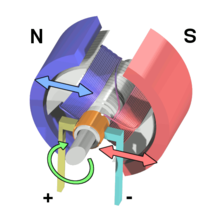Permanent magnet motor

A permanent magnet motor is a type of electric motor that uses permanent magnets in addition to windings on its field, rather than windings only.
Use in electric vehicles[]
This type of motor is used in GM's Chevrolet Bolt[1] and Volt, and the rear wheel drive of Tesla's Model 3.[2] Recent dual motor Tesla models use a combination of a permanent magnet motor at the back and traditional induction motor at the front.[3]
Permanent magnet motors are more efficient than induction motor or motors with field windings for certain high-efficiency applications such as electric vehicles. Tesla's chief motor designer was quoted discussing these advantages, saying:
It's well known that permanent magnet machines have the benefit of pre-excitation from the magnets, and therefore you have some efficiency benefit for that. Induction machines have perfect flux regulation and therefore you can optimize your efficiency. Both make sense for variable-speed drive single-gear transmission as the drive units of the cars. So, as you know, our Model 3 has a permanent magnet machine now. This is because for the specification of the performance and efficiency, the permanent magnet machine better solved our cost minimization function, and it was optimal for the range and performance target. Quantitatively, the difference is what drives the future of the machine, and it's a trade-off between motor cost, range and battery cost that is determining which technology will be used in the future.[2]
Environmental and supply concerns[]
Permanent magnet motors utilize several types of permanent magnet materials, including hard ferrites, alnico, samarium cobalt and neodymium iron boron. Hard ferrites are the permanent magnet material most commonly found (by weight) in permanent magnet motors. This is due to their low cost. If other factors are important (size, temperature capability, calibration, coercivity, etc.), motor design engineers typically use one of the other permanent magnet materials.
Rare earth production has the consequence of generating waste with elevated radioactivity compared to the natural radioactivity of the ores (waste that is referred to by the US EPA as TENORM, or Technologically Enhanced Naturally Occurring Radioactive Materials). China, the top producer of neodymium, restricted shipments to Japan in 2010 during a controversy over disputed ownership of islands. China imposed strict export quotas on several rare earth metals, saying it wanted to control pollution and preserve resources. The quotas were lifted in 2015. Although neodymium is relatively abundant, global demand for neodymium outstripped production by about 10% in 2017.[3]
See also[]
- Synchronous motor § Permanent-magnet motors
- Induction motor
References[]
- ^ Drive Unit and Battery at the Heart of Chevrolet Bolt EV, 11 January 2016
- ^ a b Tesla's top motor engineer talks about designing a permanent magnet machine for Model 3, 27 February 2018
- ^ a b "Tesla's electric motor shift to spur demand for rare earth neodymium". Reuters. 2018-03-13. Retrieved 2019-08-24.
External links[]
- Electric motors
- Engineering stubs